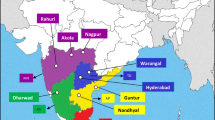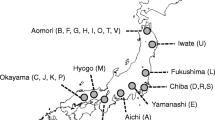Abstract
Verticillium dahliae is an agricultural phytopathogen of notable importance around the world and is increasingly impacting the billion-dollar Australian cotton industry. In diseased Australian cotton, the VCG classification system of V. dahliae does not adequately reflect the disease symptoms observed. The non-defoliating VCG2A isolates have caused significant damage, a problem not readily observed overseas, and the defoliating VCG1A isolates have not always caused widespread severe symptoms as expected. This study examined a selection of V. dahliae isolates derived from diseased cotton plants in NSW, Australia, America and Israel and classified them into groups using Inter-Simple Sequence Repeats (ISSR). A subset of these isolates were tested in a pathogenicity assay using cotton plants. The combined results confirmed that Australia has VCG2A isolates capable of causing significant disease (“defoliating-like”) and that when analysed using ISSR, they are distinct from the non-virulent VCG2A populations. Additionally, there is a group of VCG1A isolates that are able to cause significant damage to cotton plants. The ISSR analysis provides a better understanding of the V. dahliae populations circulating within Australia and is a useful tool for diagnostic use, with a potential use for diagnostic confirmation of a causative strain.





Similar content being viewed by others
References
Amyotte SG, Tan X, Pennerman K, del Mar Jimenez-Gasco M, Klosterman SJ, Ma LJ, Dobinson KF, Veronese P (2012) Transposable elements in phytopathogenic Verticillium spp.: insights into genome evolution and inter- and intra-specific diversification. BMC Genomics 13:1–20. https://doi.org/10.1186/1471-2164-13-314
Arsenault JL, Poulcur S, Messier C, Guay R (1995) WinRHlZO™, a root-measuring system with a unique overlap correction method. HortSci 30:906D – 906. https://doi.org/10.21273/HORTSCI.30.4.906D
Bhat RG, Subbarao KV (1999) Host range specificity in Verticillium dahliae. Phytopathology 89:1218–1225. https://doi.org/10.1094/PHYTO.1999.89.12.1218
Butler D, Cullis B, Gilmour A, Gogel BJ (2009) ASReml-R Reference Manual, 3. Training and Development Series, No. QE02001. Queensland Department of Primary Industries
Chapman TA, Chambers GA, Kirkby K, Jiménez-Díaz RM (2016) First report of the presence of Verticillium dahliae VCG1A in Australia. Australas Plant Dis Notes 11:1–4. https://doi.org/10.1007/s13314-016-0197-2
Chen JY, Liu C, Gui YJ, Si KW, Zhang DD, Wang J, Short Dylan PG, Huang JQ, Li NY, Liang Y, Zhang WQ, Yang L, Ma XF, Li TG, Zhou L, Wang BL, Bao YM, Subbarao Krishna V, Zhang GY, Dai XF (2017) Comparative genomics reveals cotton-specific virulence factors in flexible genomic regions in Verticillium dahliae and evidence of horizontal gene transfer from Fusarium. New Phytol 217:756–770. https://doi.org/10.1111/nph.14861
Cotton Australia (2016) Cotton Annual 2016 Australian Cotton Industry Statistics. https://cottonaustralia.com.au/assets/general/Publications/Cotton-Annuals/Cotton-Annual-2016.pdf Accessed 29 May 2018
Daayf F (2015) Verticillium wilts in crop plants: Pathogen invasion and host defence responses. Can J Plant Pathol 37:8–20. https://doi.org/10.1080/07060661.2014.989908
Daayf F, Nicole M, Geiger J-P (1995) Differentiation of Verticillium dahliae populations on the basis of vegetative compatibility and pathogenicity on cotton. Eur J Plant Pathol 101:69–79. https://doi.org/10.1007/BF01876095
Dadd-Daigle P, Kirkby K, Collins D, Cuddy W, Lonergan P, Roser S, Chowdhury PR, Labbate M, Chapman TA (2020) Virulence not linked with vegetative compatibility groups in Australian cotton Verticillium dahliae isolates. Aust J Crop Sci 14:633–640
ElSharawy AA, Yang G, Hu X, Yang J (2015) Genetic relationships between virulence, vegetative compatibility and ISSR marker of Verticillium dahliae isolated from cotton. Arch Phytopathol Pflanzenschutz 48:646–663. https://doi.org/10.1080/03235408.2015.1091164
Faino L, Seidl MF, Shi-Kunne X, Pauper M, van den Berg GCM, Wittenberg AHJ, Thomma BPHJ (2016) Transposons passively and actively contribute to evolution of the two-speed genome of a fungal pathogen. Genome Res 26:1091–1100. https://doi.org/10.1101/gr.204974.116
Hannah M, Quigley P (1996) Presentation of ordinal regression analysis on the original scale. Biometrics 52:771–775. https://doi.org/10.2307/2532917
Inderbitzin P, Bostock RM, Davis RM, Usami T, Platt HW, Subbarao KV (2011) Phylogenetics and taxonomy of the fungal vascular wilt pathogen Verticillium, with the descriptions of five new species. PLoS ONE 6:e28341. https://doi.org/10.1371/journal.pone.0028341
Jensen M, Redfern R (2017) Breaking the Verticillium cycle. Cotton Research and Development Corporation Spotlight Magazine vol. Winter 2017:11. http://www.crdc.com.au/sites/default/files/pdf/Winter17_sc_0.pdf Accessed 29 May 2018
Jiménez-Díaz RM, Olivares-García C, Trapero-Casas JL, Jiménez-Gasco MM, Navas-Cortés JA, Landa BB, Milgroom MG (2016) Variation of pathotypes and races and their correlations with clonal lineages in Verticillium dahliae. Plant Pathol 66:651–666. https://doi.org/10.1111/ppa.12611
Jin L, Li G, Yu D, Huang W, Cheng C, Liao S, Wu Q, Zhang Y (2017) Transcriptome analysis reveals the complexity of alternative splicing regulation in the fungus Verticillium dahliae. BMC Genomics 18:130. https://doi.org/10.1186/s12864-017-3507-y
Kearse M, Moir R, Wilson A, Stones-Havas S, Cheung M, Sturrock S, Buxton S, Cooper A, Markowitz S, Duran C, Thierer T, Ashton B, Meintjes P, Drummond A (2012) Geneious Basic: An integrated and extendable desktop software platform for the organization and analysis of sequence data. Bioinformatics 28(12):1647–1649. https://doi.org/10.1093/bioinformatics/bts199
Kirkby K, Lonergan P, Cooper B, Roser S (2016) Diseases of cotton XI final report. Cotton Research and Development Corporation. http://www.insidecotton.com/xmlui/bitstream/handle/1/4483/DAN1403%20Final%20Report.pdf?sequence=1&isAllowed=y Accessed 29 May 2018
Klimes A, Dobinson KF, Thomma BPHJ, Klosterman SJ (2015) Genomics Spurs Rapid Advances in Our Understanding of the Biology of Vascular Wilt Pathogens in the Genus Verticillium. Annu Rev Phytopathol 53:181–198. https://doi.org/10.1146/annurev-phyto-080614-120224
Korolev N, Pérez-Artés E, Bejarano-Alcázar J, Rodríguez-Jurado D, Katan J, Katan T, Jiménez-Díaz RM (2001) Comparative study of genetic diversity and pathogenicity among populations of Verticillium Dahliae from cotton in Spain and Israel. Eur J Plant Pathol 107:443–456. https://doi.org/10.1023/A:1011212426447
López-Escudero FJ, Mercado-Blanco J (2011) Verticillium wilt of olive: a case study to implement an integrated strategy to control a soil-borne pathogen. Plant Soil 344:1–50. https://doi.org/10.1007/s11104-010-0629-2
Mercado-Blanco J, Rodríguez-Jurado D, Parrilla-Araujo S, Jiménez-Díaz RM (2003) Simultaneous Detection of the Defoliating and Nondefoliating Verticillium dahliae Pathotypes in Infected Olive Plants by Duplex. Nested Polymerase Chain Reaction Plant Disease 87:1487–1494. https://doi.org/10.1094/PDIS.2003.87.12.1487
Mercado-Blanco J, Rodríguez-Jurado D, Pérez-Artés E, Jiménez-Díaz RM (2001) Detection of the nondefoliating pathotype of Verticillium dahliae in infected olive plants by nested PCR. Plant Pathol 50:609–619. https://doi.org/10.1046/j.1365-3059.2001.00601.x
Papaioannou IA, Dimopoulou CD, Typas MA (2013) Structural and phylogenetic analysis of the rDNA intergenic spacer region of Verticillium dahliae. FEMS Microbiol Lett 347:23–32. https://doi.org/10.1111/1574-6968.12215
Puhalla JE, Mayfield JE (1974) The Mechanism of Heterokaryotic Growth in Verticillium dahliae. Genetics 76:411–422
Qin Q-M, Vallad GE, Wu BM, Subbarao KV (2006) Phylogenetic Analyses of Phytopathogenic Isolates of Verticillium spp. Phytopathology 96:582–592. https://doi.org/10.1094/PHYTO-96-0582
Quinn J, Eveleigh R, Ford B, Millyard J, Teague C, Barry C, Lee S, Devlin A, McDonald C (2018) Verticillium Wilt. Facts on Friday vol October. Cotton Seed Distributors, Wee Waa, Australia
R Core Team (2021) R: A language and environment for statistical computing. R Foundation for Statistical Computing, Vienna, Austria. https://www.R-project.org/
Simko I, Piepho H-P (2012) The Area Under the Disease Progress Stairs: Calculation Advantage and Application. Phytopathology® 102(4) 381-389. https://doi.org/10.1094/PHYTO-07-11-0216
Trapero C, Díez CM, Rallo L, Barranco D, López-Escudero FJ (2013) Effective inoculation methods to screen for resistance to Verticillium wilt in olive. Sci Hortic 162:252–259. https://doi.org/10.1016/j.scienta.2013.08.036
Wang S, Miao X, Zhao W, Huang B, Fan M, Li Z, Huang Y (2005) Genetic diversity and population structure among strains of the entomopathogenic fungus, Beauveria bassiana, as revealed by inter-simple sequence repeats (ISSR). Mycol Res 109:1364–1372. https://doi.org/10.1017/S0953756205003709
Zhang DD, Wang XY, Chen JY, Kong ZQ, Gui YJ, Li NY, Bao YM, Dai XF (2016) Identification and characterization of a pathogenicity-related gene VdCYP1 from Verticillium dahliae. Sci Rep 6:27979. https://doi.org/10.1038/srep27979
Zhang WQ, Gui YJ, Short DPG, Li TG, Zhang DD, Zhou L, Liu C, Bao YM, Subbarao KV, Chen JY, Dai XF (2018) Verticillium dahliae transcription factor VdFTF1 regulates the expression of multiple secreted virulence factors and is required for full virulence in cotton. Mol Plant Pathol 19:841–857. https://doi.org/10.1111/mpp.12569
Acknowledgements
This project is supported by funding from the Australian Government Department of Agriculture as part of its Rural R&D for Profit programme, the Cotton Research and Development Corporation, and AUSGEM. Thank you to Dr Terry Wheeler for supplying three V. dahliae isolates, Dr Libo Shan from Texas A&M University for allowing the use of her laboratory facilities for DNA extractions, and to Leah Tsror (Lahkim), Dept of Plant Pathology and Weed Research, ARO, Volcani Center, Gilat Research Center, for supplying DNA of six isolates from Israel. John Webster and Bernie Dominiak reviewed and improved an earlier version of this manuscript.
Author information
Authors and Affiliations
Corresponding author
Ethics declarations
Conflict of interest
The authors declare that they have no conflict of interest.
Supplementary Information
Below is the link to the electronic supplementary material.
Rights and permissions
About this article
Cite this article
Dadd-Daigle, P., Collins, D., Kirkby, K. et al. Characterisation of Verticillium dahliae by inter-simple sequence repeats identified a virulent subpopulation affecting Australian cotton. Australasian Plant Pathol. 51, 409–418 (2022). https://doi.org/10.1007/s13313-022-00865-w
Received:
Accepted:
Published:
Issue Date:
DOI: https://doi.org/10.1007/s13313-022-00865-w




